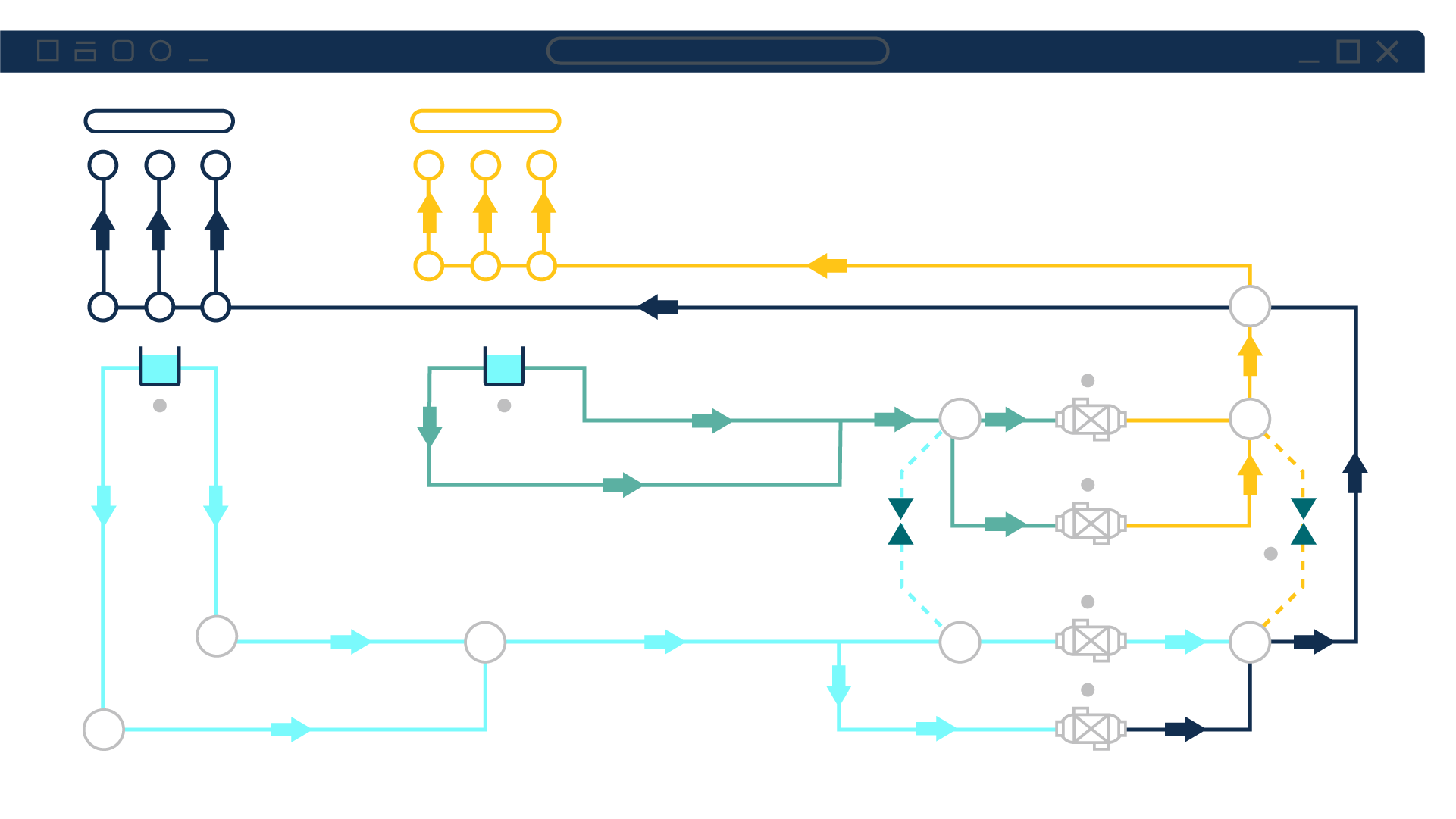Quickly build, view, and validate complex pipe networks—all in a single intuitive graphical environment
Track and compare multiple design or operating cases within one file, enabling rapid “what‑if” comparisons
Automated Network Sizing calculates capital costs (pipes, components) or ongoing energy use to help optimize designs for both initial budget and lifecycle efficiency
Supports complex fluids and systems—including non‑Newtonian slurries, variable‑speed pumps, heat transfer, and goal‑seeking controls—making it ideal for rigorous engineering applications

Track and compare multiple design cases, operating conditions, and system states with powerful tools in a single environment.
Model centrifugal and positive displacement pumps with real-world fidelity and evaluate performance under varying operating conditions.
Balance initial investment with long-term energy consumption by analyzing capital and operational expenses.
Ensure your design adheres to critical regulatory and engineering standards for performance and safety.
Accelerate model building with built-in databases and optional extensions for fluid property data.
Accurate Hydraulic Analysis for Complex Slurry Flows
Models the effects of pumping fluids containing settling solids using the Wilson/GIW method. Used with either Fathom or Impulse.
Identifies input parameters that yield desired output values and simulates control functions. Used with either Fathom or Arrow.
Models dynamic system behavior in steady-state flow and how critical system parameters vary over time. Used with either Fathom or Arrow.
Evaluates the complex interaction of system variables to reveal combinations of cost savings. Used with either Fathom or Arrow.
The Chempak add-on utility provides a thermophysical database of almost 700 liquids and 600 gases with mixing capability.
Helps identify pipe acoustical frequencies to avoid resonance from excitation, especially in systems with positive displacement pumps and reciprocating compressors. Used with either Impulse or xStream

We have answers! Here are some of the most common questions we hear from engineers and companies evaluating Fathom. Topics include software verification, model size limits, non-Newtonian fluids, system applications (HVAC, ventilation, fire protection), cost analysis, and optimization.
There are several aspects to software verification.
First, it has been compared to published data where it exists. Available published data is usually for a single pipe, which is not very challenging for a network solver. Models, comparisons and explanations for such published predictions are given in the Verification folder.
Second, it can be verified that predictions agree with the fundamental equations for networks. Finally, predictions have been compared to test data and other analytical methods on numerous occasions and good agreement has been shown.
There are no theoretical limits to model size, but there are a few practical limits. First, Fathom accepts pipe and junction ID numbers up to 9999. This limits the model size to 10,000 pipes and 10,000 junctions. Before you reach that limit, however, you will likely encounter a limitation of your available RAM to hold all of the solver parameters. To determine how much RAM you need, add up the number of branches and tees in the model. Take the square of this number. Then multiply it by 32 to get the amount of RAM that must be available. For example, with 1,000 branches and tees, the square is 1 million, and after multiplying by 32 you need 32 million bytes of RAM (i.e., 32 MB).
Yes, Fathom offers several non-Newtonian fluid models including Power Law, Bingham Plastic, and Herschel–Bulkley.
Yes, Fathom can model ducts or other air or liquid cooling systems by representing rectangular geometry as a non-cylindrical pipe using a hydraulic diameter. Since Fathom assumes incompressible flow, this may be acceptable for some systems, but for cases where fluid compressibility is important, Arrow is typically the better choice.
Yes. The Spray Discharge junction is perfectly appropriate for fire sprinklers. The fire sprinkler K values can be entered directly into the Spray Discharge. In addition, Spray Discharge junctions can be turned on or off with a single mouse click. Evaluating multiple fire location scenarios is easily done, and use of the Scenario Manager allows all cases to be kept in the same model file.
Yes, the Scenario Manager lets you create dependent design cases where changes are inherited by children.
No. Depending on your goal, you need only specify the costs for which you are interested. If you are looking for just a first-cost estimate, then you need to only specify Material and possibly Installation. Remember, these are very broad categories and can be tailored to meet your specific application.
Costs are entered in a one or more user-defined Cost Databases using the Cost Database editor. You can keep separate databases for each type of cost or put all the costs for a project into one database. These databases can also be used in multiple models and can be shared among all the users over a network.
You can specify an Interest Rate and an Inflation Rate which are used over the System Life.
While there is no limit, the time required to find a solution will increase with the number of variables and goals that must be solved since the number of possible variations increases exponentially with the number of variables and goals. Fathom GSC employs a robust and efficient numerical optimization engine to be able to handle models with large numbers of variables and goals.
Steady-State Compressible Flow Modeling. Calculate pressure drop and flow distribution in gas and steam systems
Surge analysis software used to calculate high-pressure transients in liquid piping systems caused by water hammer.
dynamic simulation tool for high-speed, acoustic transients that occur in steam and gas piping systems.
Robust chemical process simulation software designed to meet the diverse needs of engineers who design, troubleshoot, and innovate.